Remember how I always tell you that you need to research a little before purchasing your favorite fish for your tank? Well, if you have Clownfish on your favorite list, this article is exactly what you should look for when you do your research. Because not every fish can live with Clownfish.
A lot of fish can live with Clownfish! Some suitable tankmates can be Mandarin Dragonet, Dartfish, Red Coris Wrasse, Yellow Tang, Basslets, Chromis Damselfish, Pygmy Angelfish, Butterflyfish, Pseudochromis, Blenny, Banggai Cardinalfish, etc.
The article is going to discuss each of the fish’s characteristics and their relationship with Clownfish. So, again, if you plan to have Clownfish, keep reading because you have to know the fish well that can be the perfect tank mates for your Clownfish.
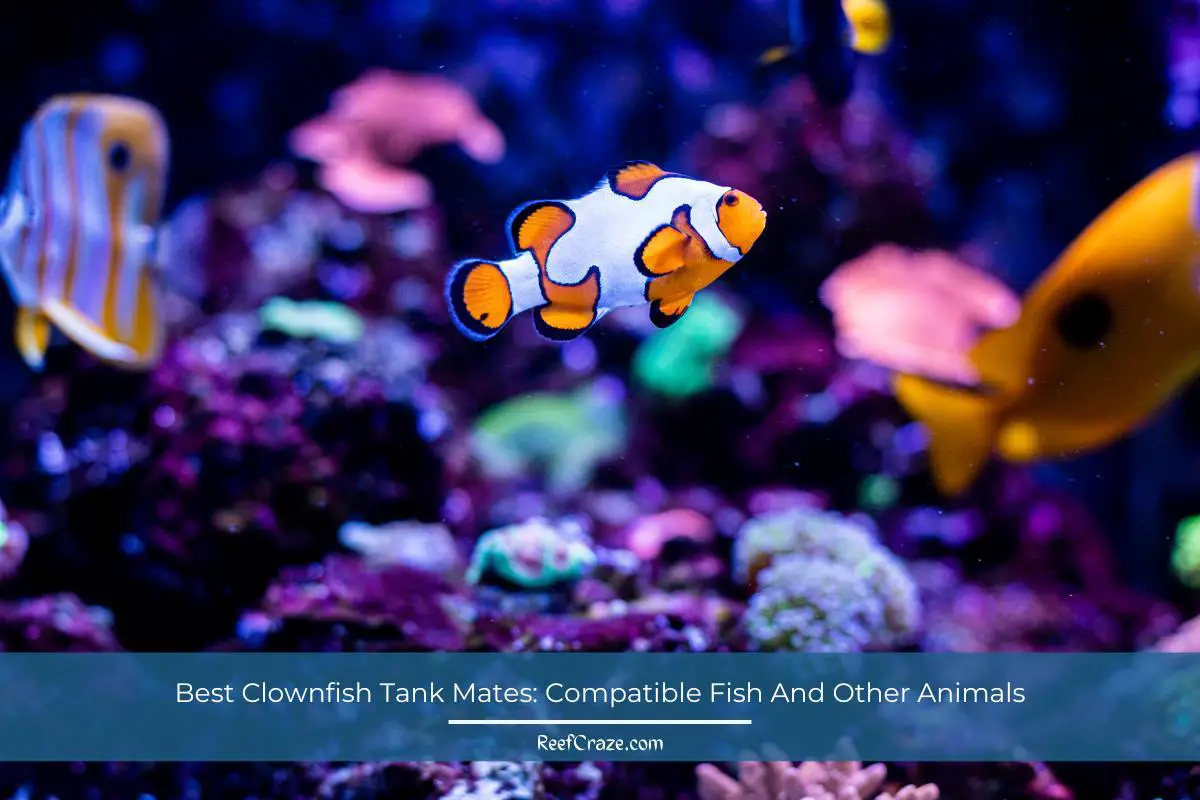
Survey Data From Real Saltwater Experts
Being a fishkeeping enthusiast I am member of many Saltwater Aquarium Communities. One of them is the “Saltwater Fish And Coral Keepers” Facebook Group with 43,400 members involved in this hobby!
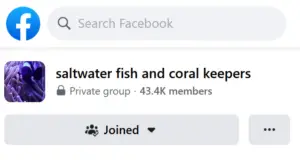
So I took the opportunity to conduct a survey and get first hand experience and data from the real clownfish keepers. Here’s is the poll result screenshot.
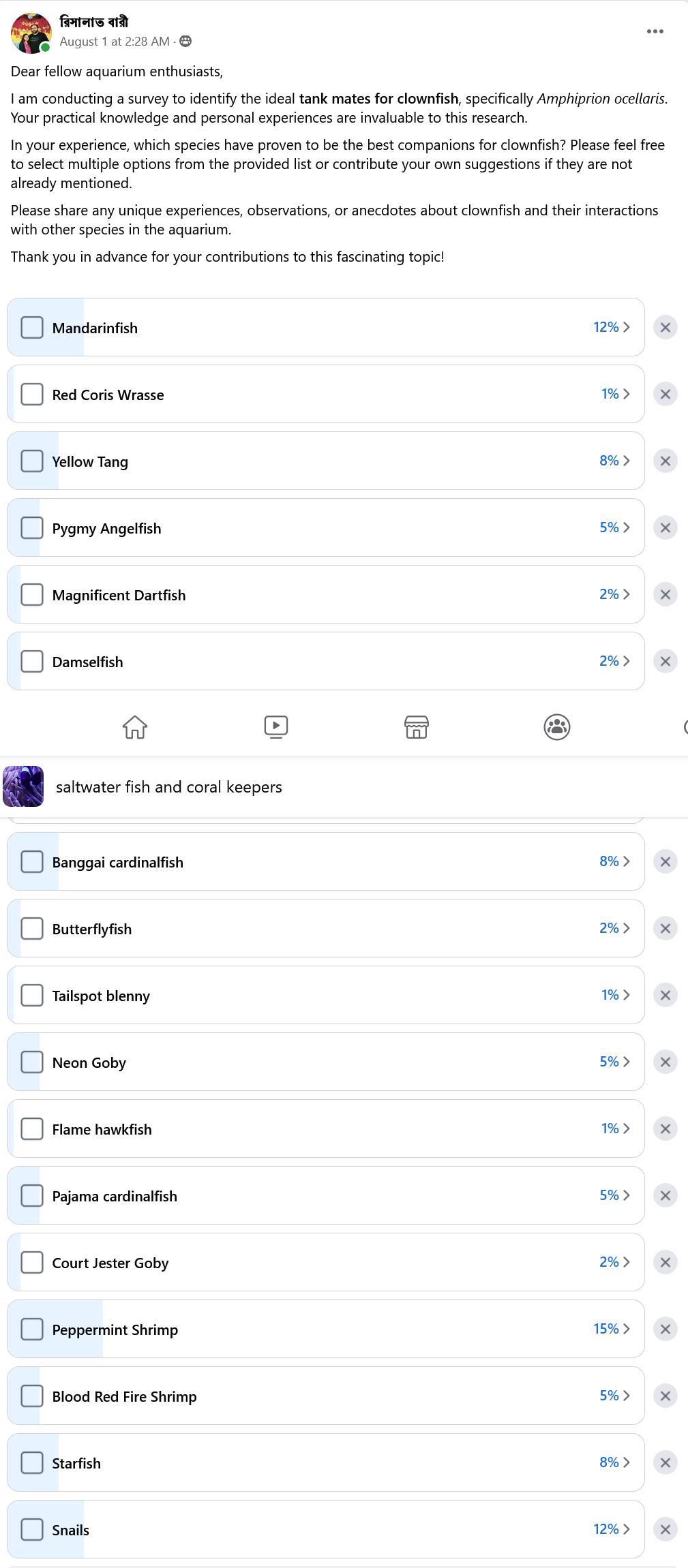
To Summarize the result, here are top 5 tank mates for clownfish that experts recommend from their real-life experience.
- Peppermint Shrimp
- Manderinfish
- Snails
- Yellow Tank
- Banggai Cardinalfish
There are some amazing stories and nuggets in the comment section as well like the below one.

Or this one –

Clownfish Behavior and Requirements
Before you introduce your clownfish to new pals, you need to know them inside out, like a well-read book. So, let’s take a tour through their lives.
Clownfish come from the warm waters of the Pacific and Indian Oceans, especially around Australia’s Great Barrier Reef. Here, they form symbiotic relationships with anemones. It’s as if they’re playing house in a dangerous neighborhood – the stinging tentacles of the anemones deter predators, while the clownfish bring food to the party.
Living in such close quarters has led to a tightly-knit social structure among clownfish. Each anemone is home to a group led by a dominant female, followed by her breeding male partner, and several non-breeding males. It’s like a quirky underwater soap opera.
The dietary requirements of clownfish mirror their adventurous spirit. They’re omnivores, happily munching on small invertebrates and algae. In a tank, you can feed them a diet of shrimp, fish flakes, or pellets.
Speaking of tanks, clownfish are easy-going about their living conditions. They’re happy in a tank of 20 gallons or more, with a temperature of around 74-78 degrees Fahrenheit. Don’t forget to mimic their natural habitat by adding a few anemones.
Primary Considerations in Selecting Clownfish Tank Mates
Selecting tank mates for clownfish is akin to matchmaking. It’s all about compatibility and harmony. We’re not setting up a gladiator arena, after all.
Compatibility of Temperament
The ocean isn’t just water, it’s a melting pot of personalities. Some fish are mild-mannered, others are boisterous, and a few have a grumpy streak. Clownfish can be territorial, especially around their anemone homes. So, a prospective tank mate should ideally be non-aggressive, like a well-behaved guest at a dinner party.
Compatibility of Size
Size matters – in the fish tank, that is. If a fish is too large, it may see the clownfish as a tasty snack. Conversely, if it’s too small, it might end up on the clownfish’s dinner plate. It’s a balancing act – think of Goldilocks and the three bears, but underwater.
Compatibility of Diet
Food can make or break friendships in the tank. It’s vital to ensure that your prospective tank mates don’t have a radically different diet from your clownfish, lest meal times turn into a battlefield.
Compatibility of Habitat Requirements
Lastly, ensure the tank mates share similar habitat requirements. It’s like housemates agreeing on the room temperature.
Best Tank Mates For Clownfish
Let’s begin with the clear choice – exploring different fish species that make appropriate companions for Clownfish. We’ll discuss each of these potential tank mates individually.
1. Mandarin Dragonet
- Scientific Name: Synchiropus splendidus
- Adult Size: Up to 3 inches
- Compatible with: Clownfish, other non-aggressive species
- Water Temperature: 72 to 78 degrees Fahrenheit
- Minimum Tank Size: 30 gallons
- Care Level: Advanced
- Origin: Pacific Ocean
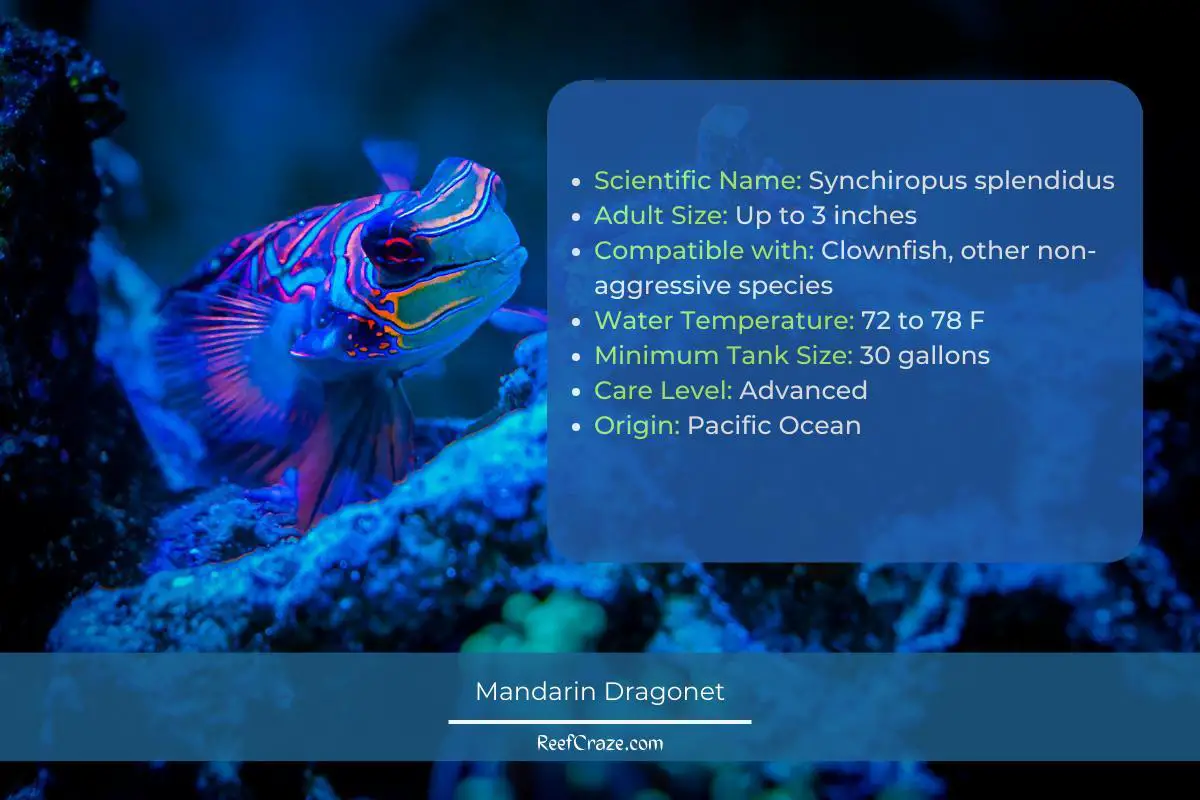
Mandarin Dragonet, a very beautiful fish, is the perfect tank mate for Clownfish because they explore completely different zones in a tank.
Dragonets usually crawl along the live rock by using their fins, looking for copepods. They specifically live on copepods. It means that you have to keep them in a mature reef tank and give them supplements occasionally. It also eats Mysis Shrimp, pellets, and Brine Shrimp.
Although difficult to care about, they are very peaceful. While being a gentle tank mate for your Clownfish, this vibrant looking fish with a long life span of 10 to 15 years will be a beautiful addition to your reef tank.
2. Dartfish
- Scientific Name: Ptereleotris zebra
- Adult Size: Up to 4 inches
- Compatible with: Clownfish, other peaceful species
- Water Temperature: 72 to 78 degrees Fahrenheit
- Minimum Tank Size: 30 gallons
- Care Level: Easy
- Origin: Indo-Pacific
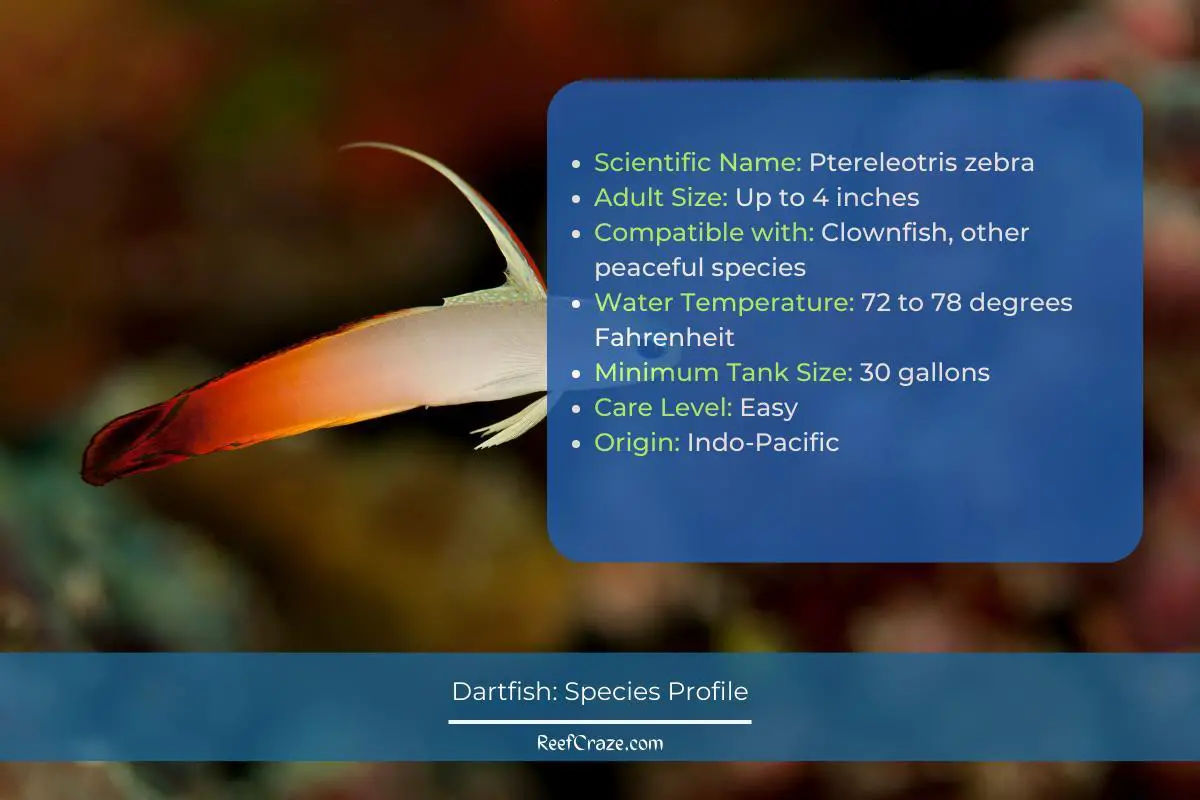
Dartfish is usually peaceful with other fish, but its temperament varies when it comes to its own species. For example, Fire Dartfish cannot tolerate each other. On the other hand, you can keep Zebra Dartfish in groups without facing any problem.
This fish usually grows up to 4 inches, which makes it a good tank mate for Clownfish. You can also keep it in a nano reef system. However, it cannot be kept with Tomato Clownfish and Maroon Clownfish, which are more aggressive.
3. Red Coris Wrasse
- Scientific Name: Coris gaimard
- Adult Size: Up to 14 inches
- Compatible with: Clownfish, not compatible with small invertebrates
- Water Temperature: 72 to 78 degrees Fahrenheit
- Minimum Tank Size: 125 gallons
- Care Level: Intermediate
- Origin: Indo-Pacific

Red Coris Wrasse usually grows as tall as afoot, but it usually grows up to 8 inches in home aquariums. It has a semi-aggressive temperament. Due to its size and temperament, it makes an ideal tank mate for large and aggressive species of Clownfish.
It lives on invertebrates such as small clams and shrimps. You have to offer it frozen invertebrates and chopped shellfish regularly with prepared food. It is suitable for both reef tanks and fish-only tanks.
4. Yellow Tang
- Scientific Name: Zebrasoma flavescens
- Adult Size: Up to 8 inches
- Compatible with: Clownfish, most other fish, can be territorial with other tangs
- Water Temperature: 72 to 78 degrees Fahrenheit
- Minimum Tank Size: 100 gallons
- Care Level: Intermediate
- Origin: Pacific Ocean
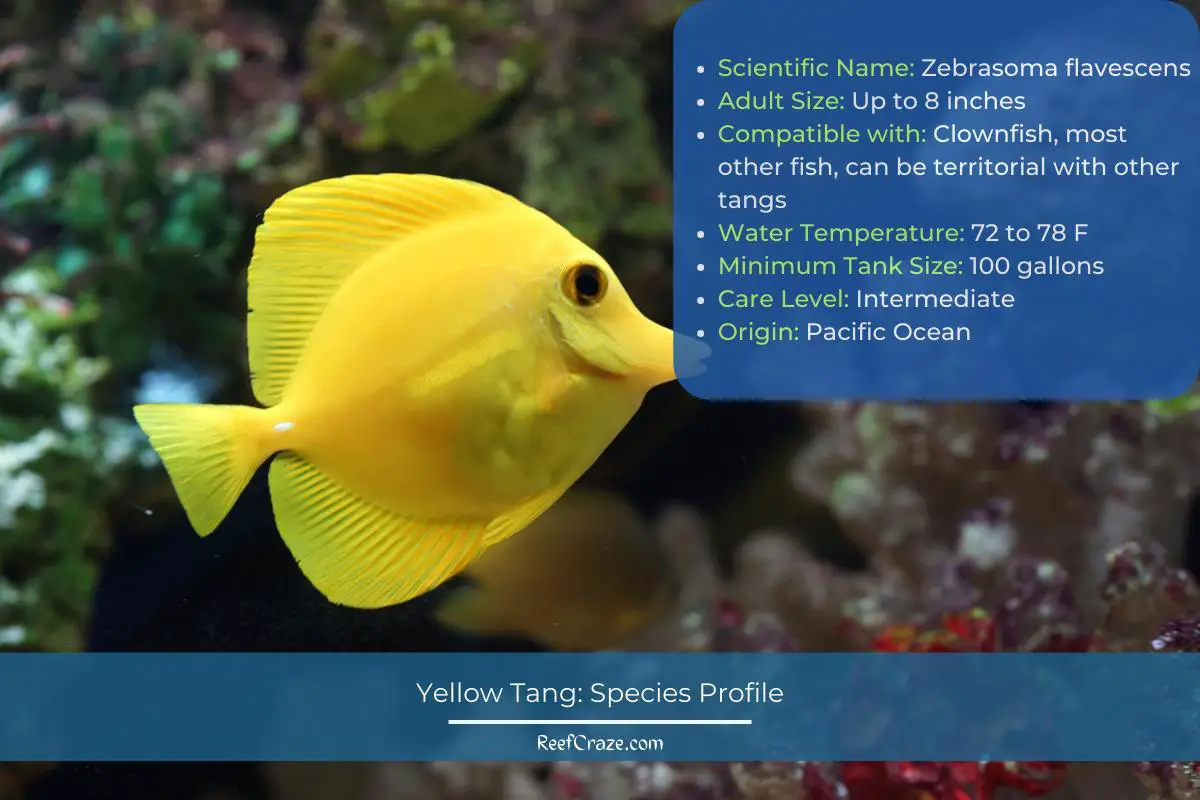
While you get melted by the mellow yellow vibe of Yellow Tangs, you should know that they can be peaceful and aggressive both at times! They are also territorial.
But they are mostly wrathful toward other Tangs. As long as you keep them with Clownfish, it’s fine because Clownfish looks different from the Tangs. They are perfect tank mates for large Clownfish like Maroon and Clarkii.
Yellow Tangs are vegetarian. You will have to give them frozen and prepared food rich in protein. They also eat cucumber and cauliflower. Other than these, they need spirulina-based prepared supplements as well.
When kept in a group, Tangs become vulnerable and suffer from Lateral Line Disease, aka Hole in the head. It happens when their diet does not have sufficient greens in it.
However, if the tank is well cycled and Yellow Tangs are added after all other tank inhabitants have been added and fed properly, they can be a good option for a new hobbyist.
Read Also: Can You Keep Blue Tang With Clownfish?
5. Basslet Fish
- Scientific Name: Gramma loreto
- Adult Size: Up to 3 inches
- Compatible with: Clownfish, other peaceful species
- Water Temperature: 72 to 78 degrees Fahrenheit
- Minimum Tank Size: 30 gallons
- Care Level: Easy
- Origin: Caribbean

This one is another great match for Clownfish. It is extremely peaceful but can be very territorial when it comes to a cave or a hiding place. It will be aggressive toward any intruder. It also cannot tolerate other Basslets.
As Clownfish doesn’t live in caves and is similar in size, it gets along well with Basslets. This carnivore fish requires subdued lighting that may make it difficult for you to keep Sea Anemones for your Clownfish, remember.
Marine plankton, Mysis Shrimp, and Brine Shrimp are the diet of this fish.
6. Chromis Damselfish
- Scientific Name: Chromis viridis
- Adult Size: Up to 3.5 inches
- Compatible with: Clownfish, most other fish
- Water Temperature: 72 to 78 degrees Fahrenheit
- Minimum Tank Size: 30 gallons
- Care Level: Easy
- Origin: Indo-Pacific

Clownfish itself is a kind of Damselfish. And a lot of Damselfish species are aggressive and territorial toward each other and their tank mates. But Chromis Damselfish is an exception in this case.
They are planktivore schooling fish with a peaceful temperament. Unlike other Damselfish, they are relatively small in size. The most common species of Damselfish that you will find in stores are Blue Reef Chromis and Green Chromis.
Both of these are hardy and easy to feed, and hence, they are great choices for beginner aquarists.
Since they are schooling fish, you have to keep at least 4 or 6 of them together as a group. Green Chromis Damselfish can grow up to 4 inches, and Blue Reef Chromis Damselfish can grow more than 5 inches.
7. Pygmy Angelfish
- Scientific Name: Centropyge argi
- Adult Size: Up to 3 inches
- Compatible with: Clownfish, not compatible with large, aggressive fish
- Water Temperature: 72 to 78 degrees Fahrenheit
- Minimum Tank Size: 70 gallons
- Care Level: Intermediate
- Origin: Western Atlantic
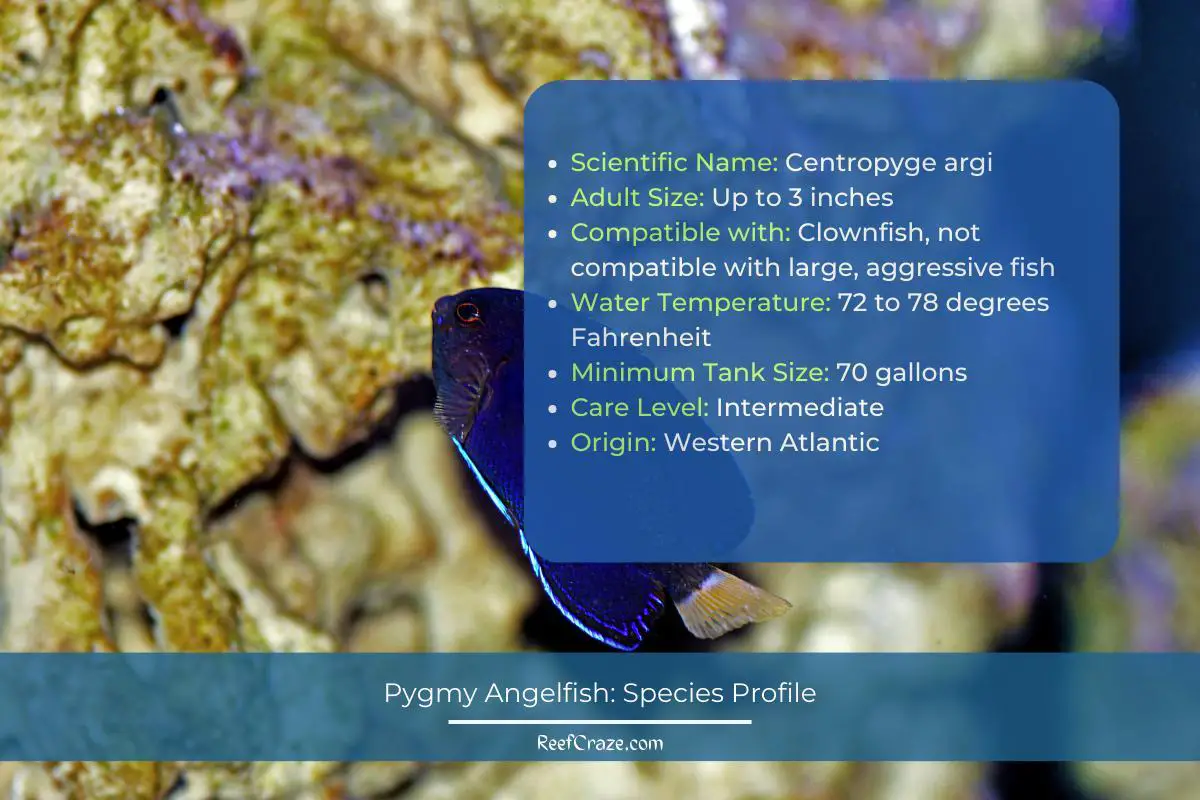
All types of Angelfish quickly get along with Clownfish. But Pygmy Angelfish is recommended because its size is similar to that of Clownfish. It is better to avoid the large Angelfish species because they are a little aggressive.
This fish feeds on algae, sponges, bryozoans, and other organisms that encrust on the live rock in a tank. If you choose a type of Angelfish that mostly eats sponges, make sure that you keep a different preparation for the Angelfish specifically. Potter’s, Lemonpeel, and Flame are among the notable species of Angelfish.
However, keep in your mind that most of the species of Angelfish are not reef-friendly.
8. Butterflyfish
- Scientific Name: Chaetodon kleinii
- Adult Size: Up to 6 inches
- Compatible with: Clownfish, may nip at invertebrates and corals
- Water Temperature: 72 to 78 degrees Fahrenheit
- Minimum Tank Size: 125 gallons
- Care Level: Intermediate
- Origin: Indo-Pacific
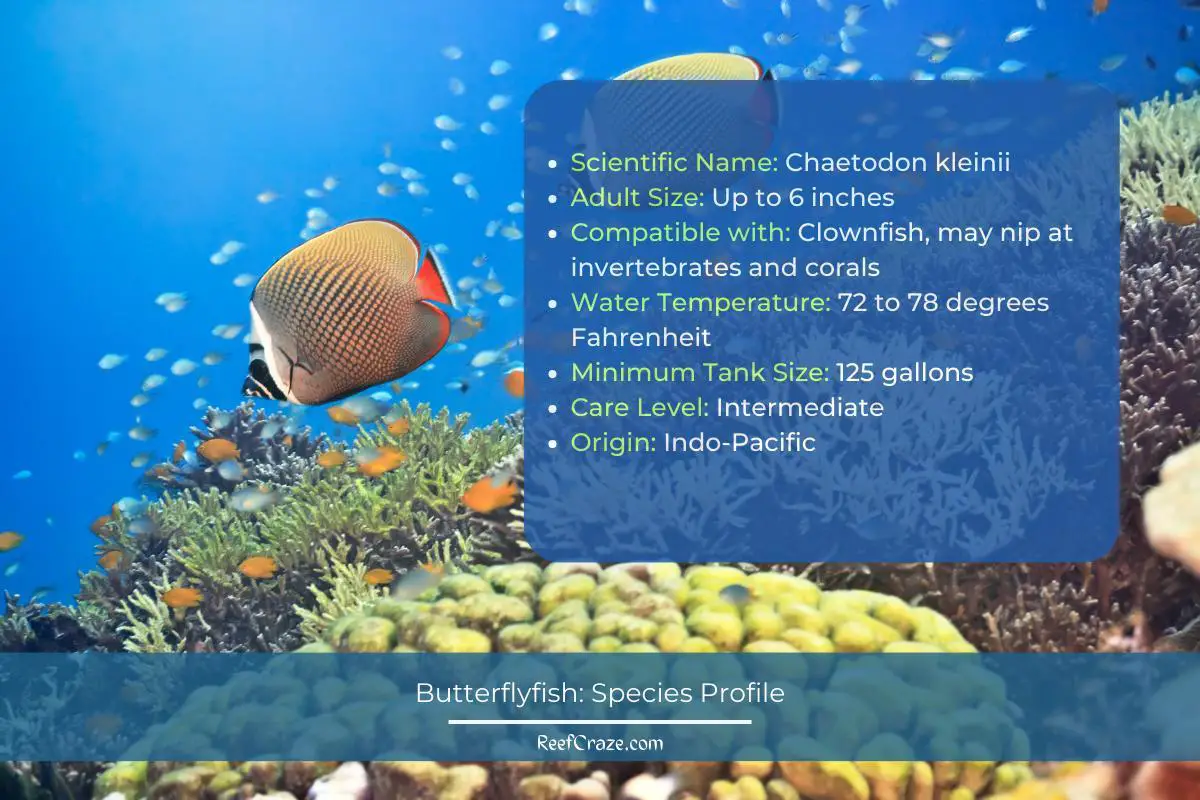
Butterflyfish, another good match for Clownfish, prefers to swim in areas with lots of oceanic plants and reefs. It comes in different combinations of colors like white, yellow, black, orange, red-orange, and blue. Its maximum growth is 8.7 inches.
Butterflyfish is vulnerable to Black Ich and Dropsy. It has a red or swollen belly when it suffers from Dropsy. In the case of Black Ich, it gets dark spots in its body.
It feeds on plankton, artemia, and sponge-based frozen food. This fish will require you to have a tank of at least 75 gallons of water. Besides, be aware of the levels of nitrate in your tank water because it often dies because of nitrate poisoning.
9. Pseudochromis
- Scientific Name: Pseudochromis fridmani
- Adult Size: Up to 3 inches
- Compatible with: Clownfish, can be aggressive with similar species
- Water Temperature: 72 to 78 degrees Fahrenheit
- Minimum Tank Size: 30 gallons
- Care Level: Easy
- Origin: Red Sea
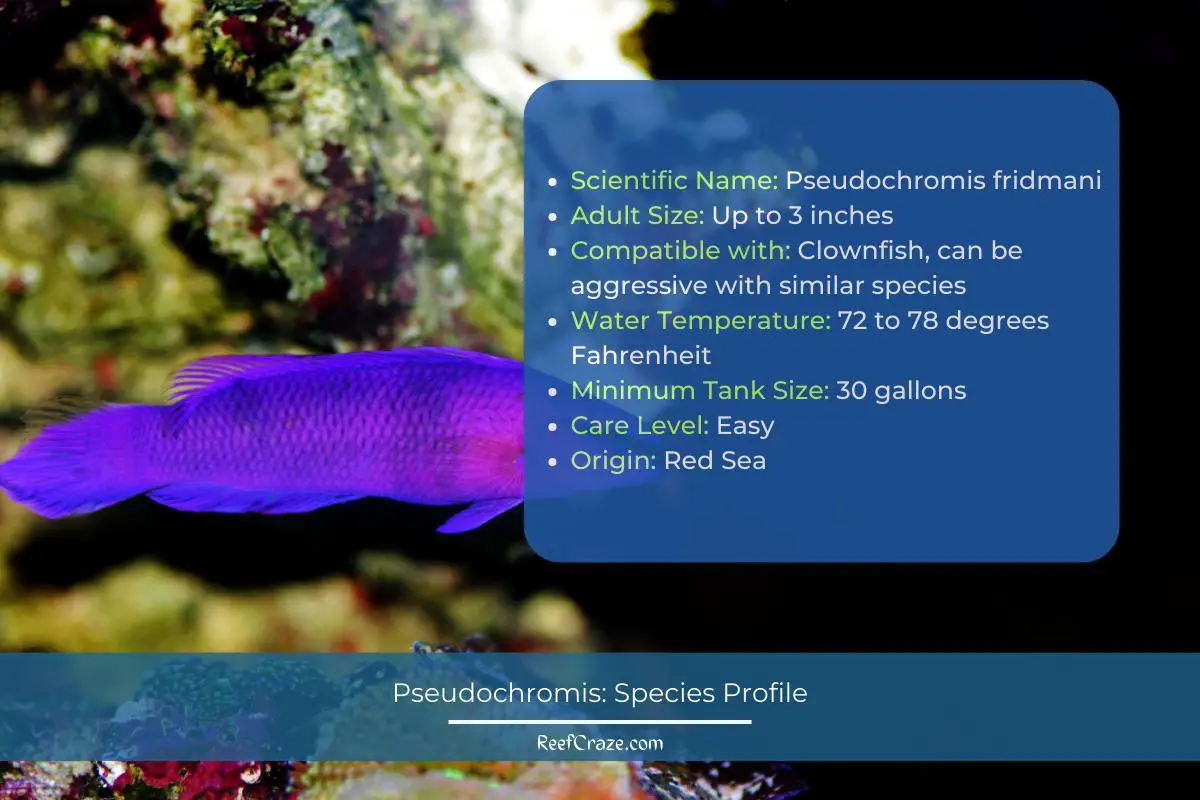
Pseudochromis swims in the areas that are heavily reefed and suitable for laying eggs and searching for food. Its diet includes dried and frozen worms, shrimps, and fish flakes.
The nature of this fish is quite aggressive. If you have a tank of Clownfish community tank, raising 3 Pseudochromis fish will be just fine. But remember that your community tank has to be large so that your Pseudochromis fishes cannot mess with your Clownfish.
10. Blenny
- Scientific Name: Ecsenius bicolor
- Adult Size: Up to 5 inches
- Compatible with: Clownfish, other peaceful species
- Water Temperature: 72 to 78 degrees Fahrenheit
- Minimum Tank Size: 30 gallons
- Care Level: Easy
- Origin: Indo-Pacific
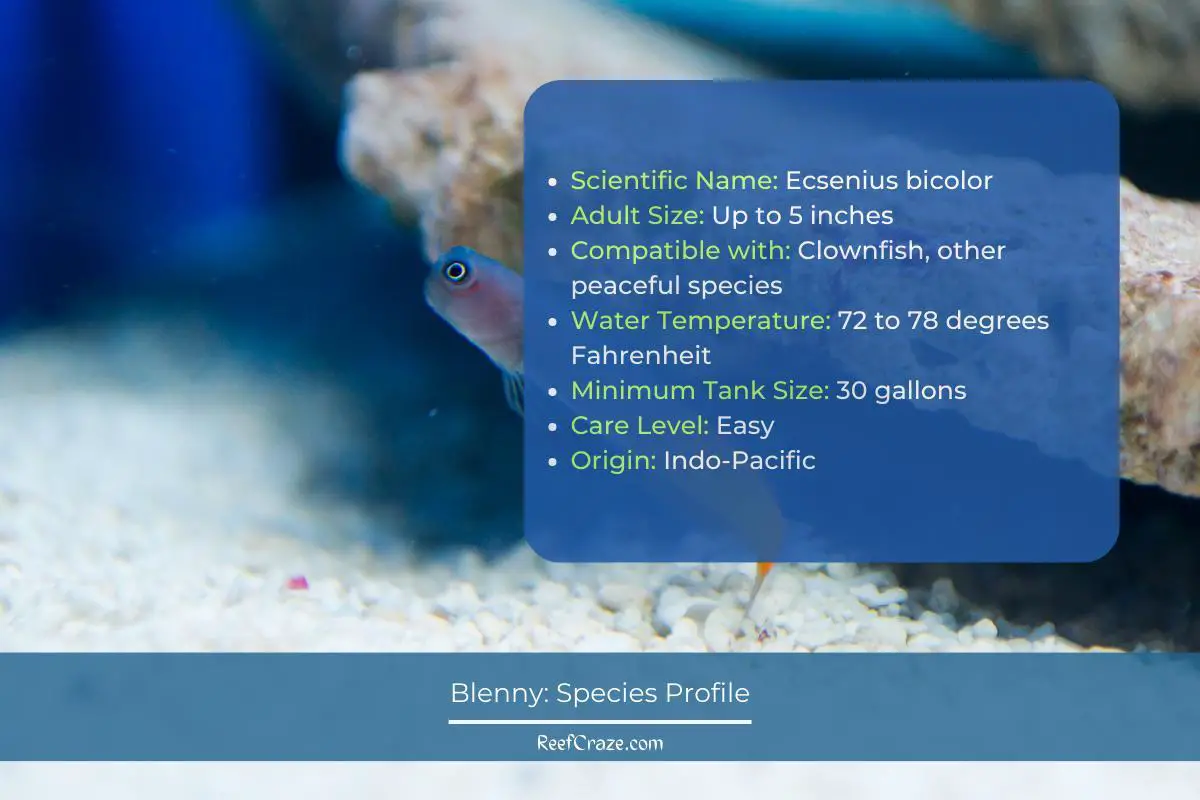
Because of their streamlined shape, Blennies look like the mini version of Eels. They can be of different colors like brown, yellow, orange, silver, black, etc.
They dwell in the bottom of the tank. If you think about adding Blennies to your tank, get a sand substrate or gravel for them first.
They are as tiny as 3 inches only. You can get them at a cheap price. If you have a fixed budget, Blennies would be a good choice for you.
11. Banggai Cardinalfish
- Scientific Name: Pterapogon kauderni
- Adult Size: Up to 3 inches
- Compatible with: Clownfish, peaceful species
- Water Temperature: 72 to 78 degrees Fahrenheit
- Minimum Tank Size: 30 gallons
- Care Level: Easy
- Origin: Banggai Islands, Indonesia
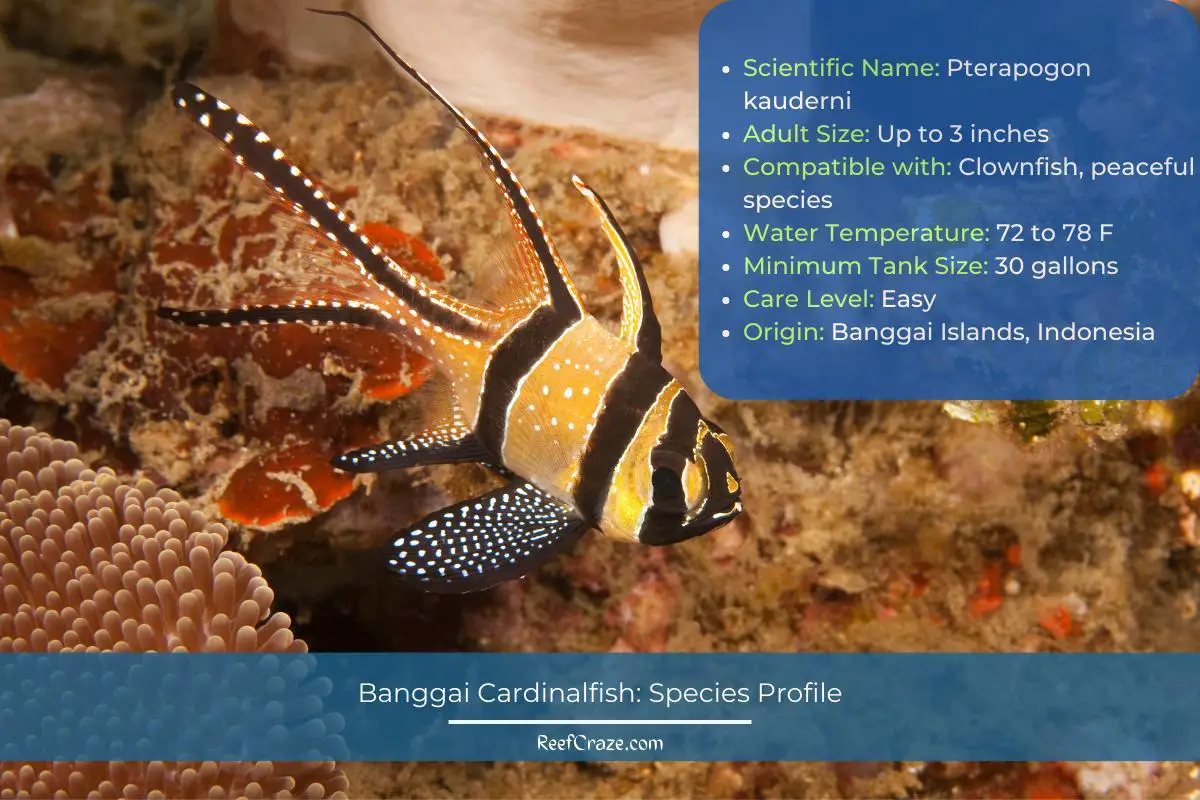
Banggai Cardinalfish is also a little aggressive. But it usually does not attack Clownfish in a community tank. However, if you have Sea Anemones in the tank, consider keeping the Cardinalfish’s hiding place at the tank’s edge.
The fish feeds on bloodworms, marine flesh, and Feeder Shrimp. It also comes at an affordable price.
12. Firefish
- Scientific Name: Nemateleotris magnifica
- Adult Size: Up to 3 inches
- Compatible with: Clownfish and other non-aggressive species Water
- Temperature: 72 to 78 degrees Fahrenheit
- Minimum Tank Size: 20 gallons
- Care Level: Easy
- Origin: Indo-Pacific
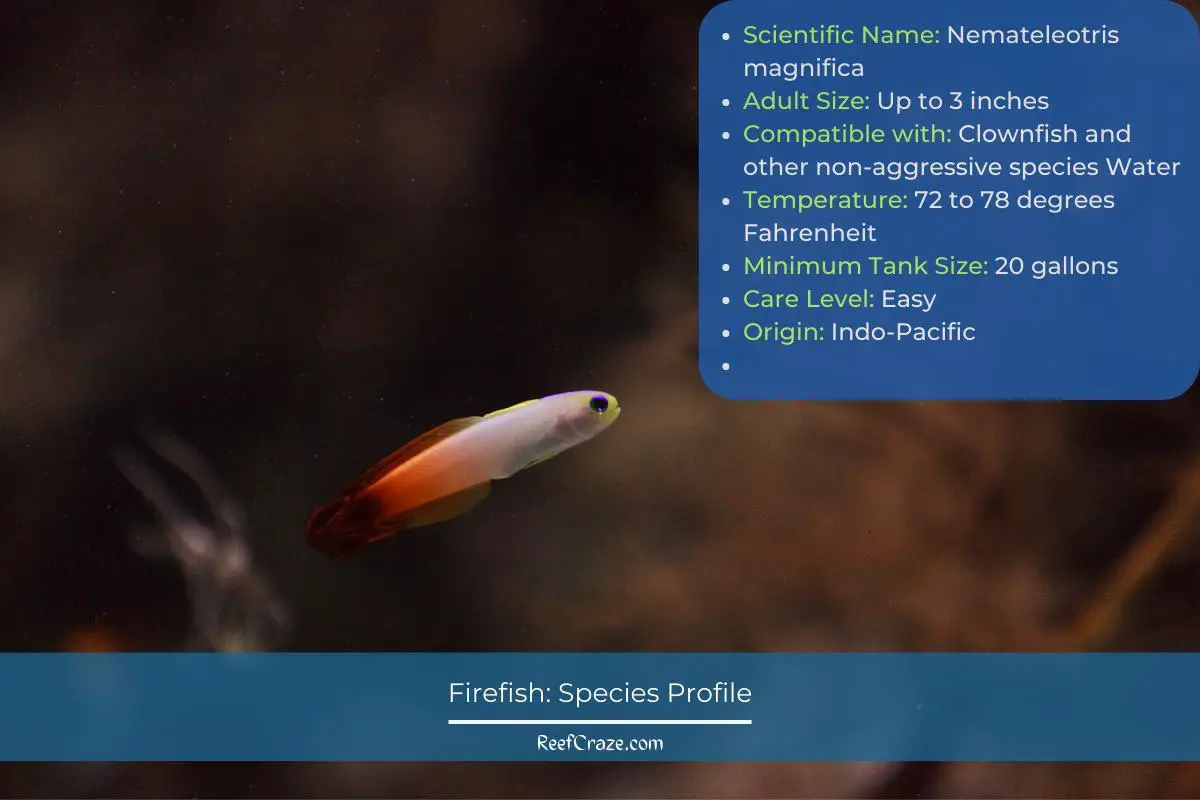
Firefish, also known as the Fire Dartfish, are sought after due to their striking coloration and peaceful demeanor. Their compatibility with clownfish is well-established and generally trouble-free given both species have non-aggressive temperaments. However, firefish can be somewhat timid and skittish. They prefer a well-structured reef environment with plenty of hiding spots.
While there aren’t specific statistics available regarding the success rate of Firefish and clownfish cohabitation, countless anecdotal reports from hobbyists suggest a high compatibility rate. They are considered easy to care for and hardy, making them a good choice for novice aquarists.
13. Goby Fish
- Scientific Name: There are several species, but a popular one is the Yellow Watchman Goby (Cryptocentrus cinctus)
- Adult Size: Depends on species, but generally between 1.5 and 5 inches
- Compatible with: Clownfish and most reef-safe species
- Water Temperature: 72 to 78 degrees Fahrenheit
- Minimum Tank Size: 20 gallons
- Care Level: Easy
- Origin: Indo-Pacific
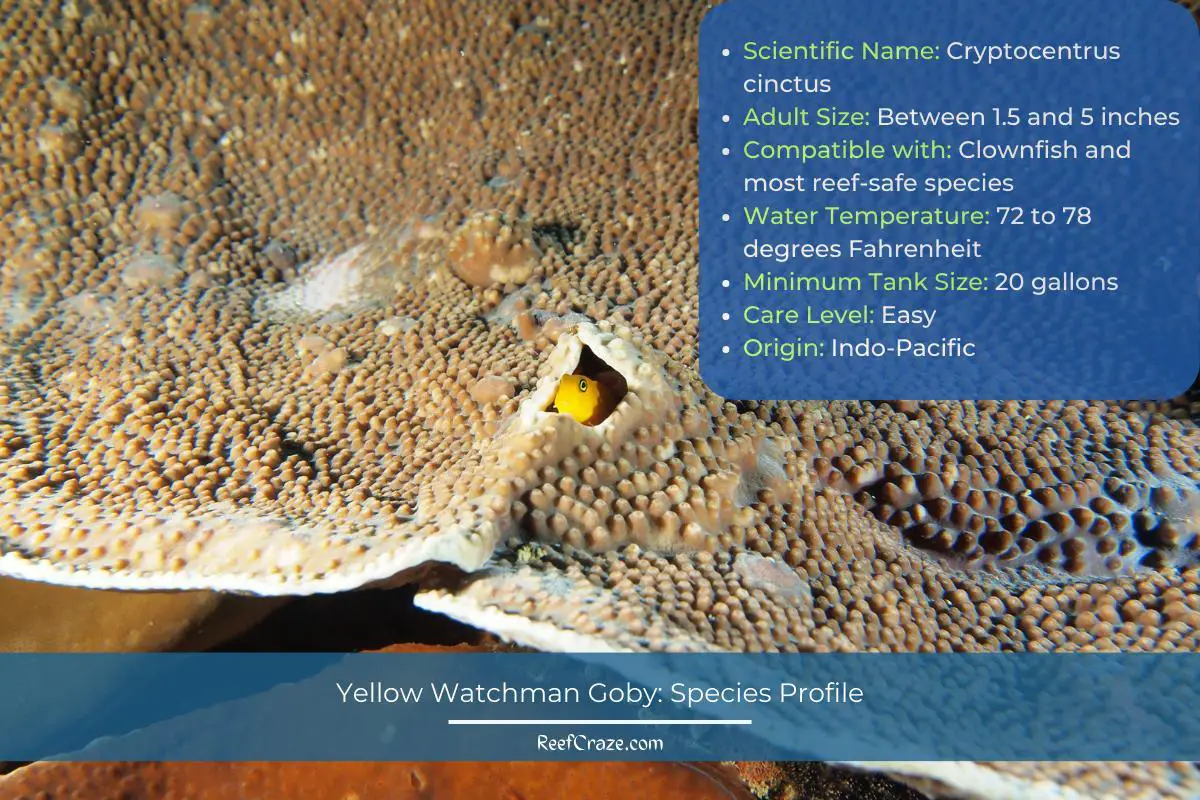
There are hundreds of Goby species, each with unique behaviors and requirements. Some are sand sifters, some are known for their symbiotic relationships with pistol shrimps, and others are known for their unique swimming styles. The Yellow Watchman Goby is a particularly popular choice. They are bottom dwellers and will often create burrows, adding an interesting dynamic to the tank.
Given their peaceful nature and preference for the lower levels of the tank, they are unlikely to cause conflicts with clownfish, making them a well-regarded tank mate. They’re also known for their hardiness and easy care, which suits both beginner and experienced aquarists.
14. Valentin’s Sharpnose Pufferfish
- Scientific Name: Canthigaster valentini
- Adult Size: Up to 5 inches
- Compatible with: Clownfish and many other species, but may nip at invertebrates
- Water Temperature: 72 to 78 degrees Fahrenheit
- Minimum Tank Size: 40 gallons
- Care Level: Easy
- Origin: Indo-Pacific
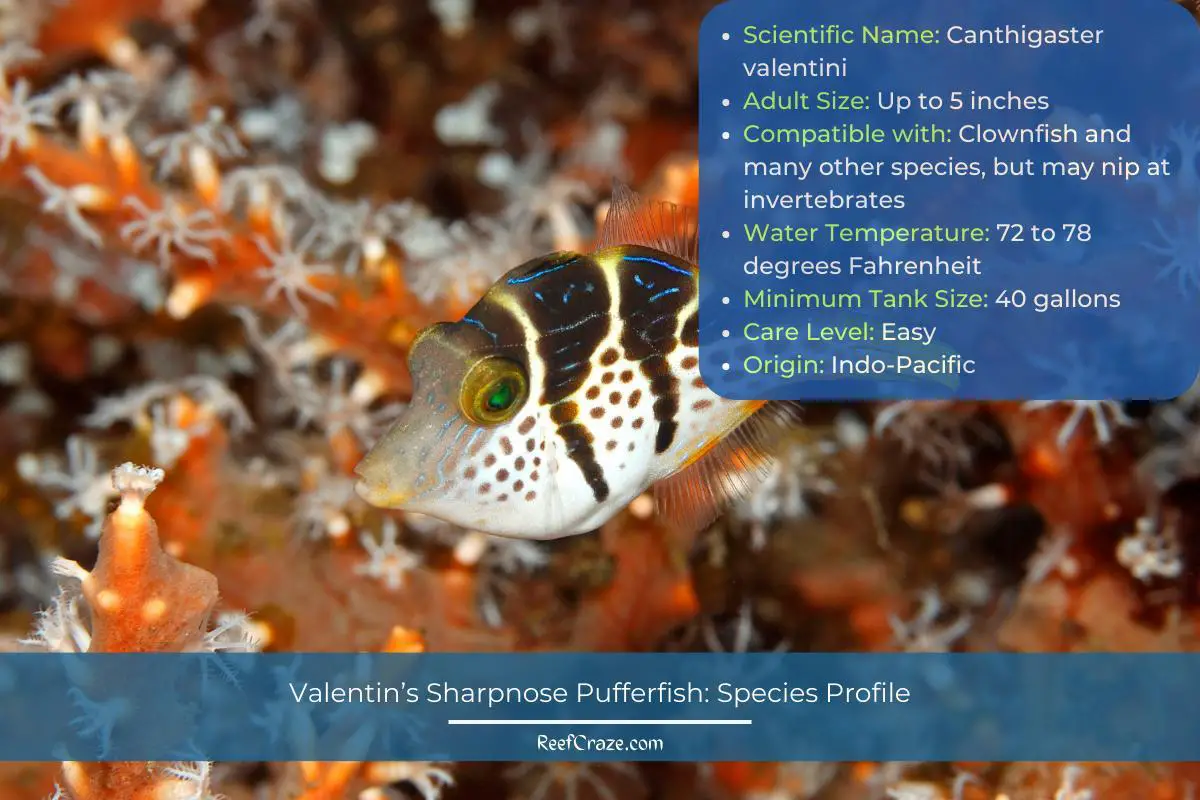
Valentin’s Sharpnose Pufferfish is a small and mostly peaceful puffer that can add personality to a tank. However, they have been known to occasionally nip at invertebrates and corals, so compatibility with a reef tank can vary. It’s essential to monitor their behavior if kept with delicate invertebrates.
While they’re generally compatible with clownfish, the specific dynamic can depend on the individual fish’s temperament. With a hearty diet of meaty foods and plenty of swimming space, they’re a durable and attractive addition to the right aquarium setup.
15. Flame Hawkfish
- Scientific Name: Neocirrhites armatus
- Adult Size: Up to 4 inches
- Compatible with: Clownfish, but may eat small shrimps and other invertebrates
- Water Temperature: 72 to 78 degrees Fahrenheit
- Minimum Tank Size: 30 gallons
- Care Level: Easy
- Origin: Pacific Ocean
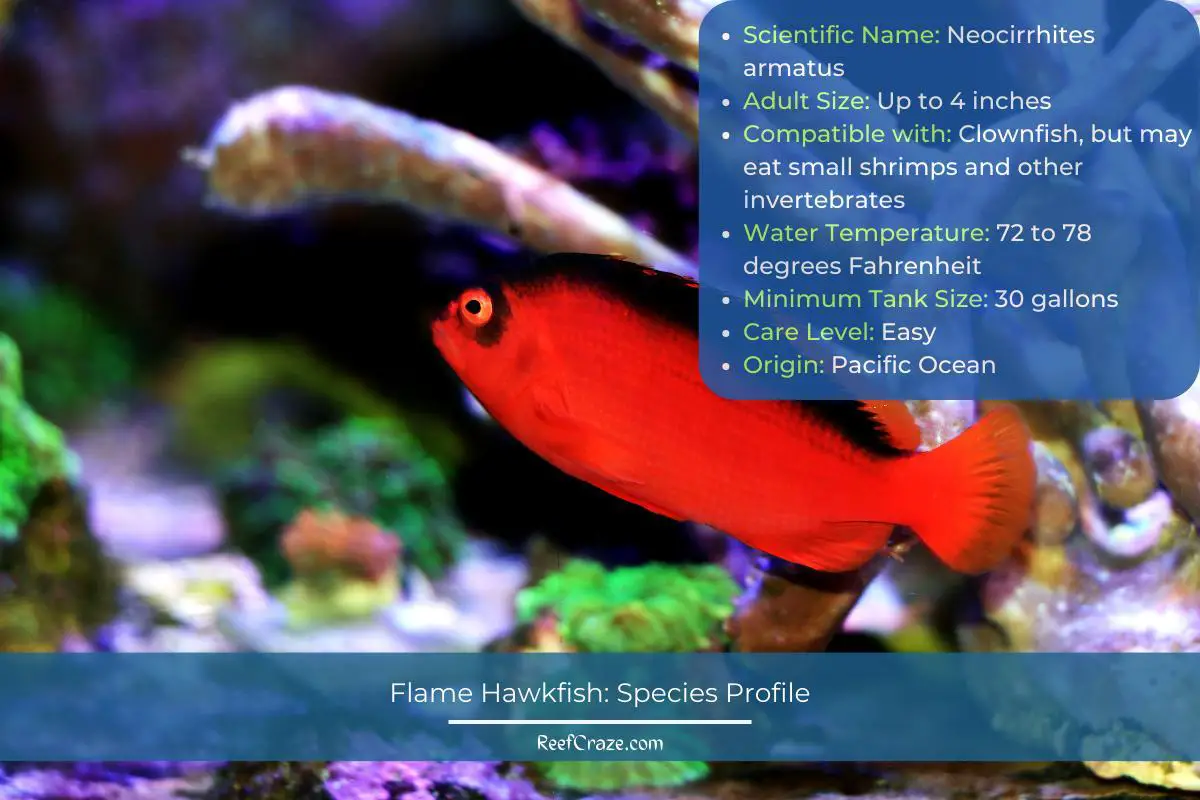
Flame Hawkfish are personable and vibrant, often becoming a favorite of their owners. However, they can present some compatibility issues. They are known to be predatory towards small invertebrates, which can be problematic in a mixed-species tank. This is a crucial consideration for any potential tank mates.
While they are compatible with clownfish, they should only be kept with larger, more robust invertebrates and with fish that they can’t easily prey upon. Due to their potential predatory nature, they require careful consideration when introducing to a reef environment.
16. Royal Dottyback
- Scientific Name: Pictichromis paccagnellae
- Adult Size: Up to 3 inches
- Compatible with: Clownfish, but can be aggressive to other Dottybacks and similar species
- Water Temperature: 72 to 78 degrees Fahrenheit
- Minimum Tank Size: 30 gallons
- Care Level: Easy
- Origin: Indo-Pacific

The Royal Dottyback, with its striking purple and yellow coloration, is a favorite among aquarists. They’re hardy and adaptable but can be aggressive and territorial, especially towards similar-looking or related species.
Compatibility with clownfish is generally good, but they may bully smaller, less assertive species. As a result, they are best kept in a tank with plenty of hiding spots and with other semi-aggressive tank mates that can hold their own.
Are There Other Animals That Can Also Live With Clownfish?
Yes, there are. Sea Anemone, Hermit Crab, Peppermint Shrimp, Harlequin Shrimp and Blood Red Fire Shrimp can also live well with Clownfish.
1. Sea Anemone
Sea Anemone shares a unique bond with Clownfish. It protects Clownfish by its stinging tentacles.
On the other hand, Clownfish defend it aggressively from its predators. Clownfish even drops food directly onto the mouth of the Anemone. Thus, there exists a symbiotic relationship between them.
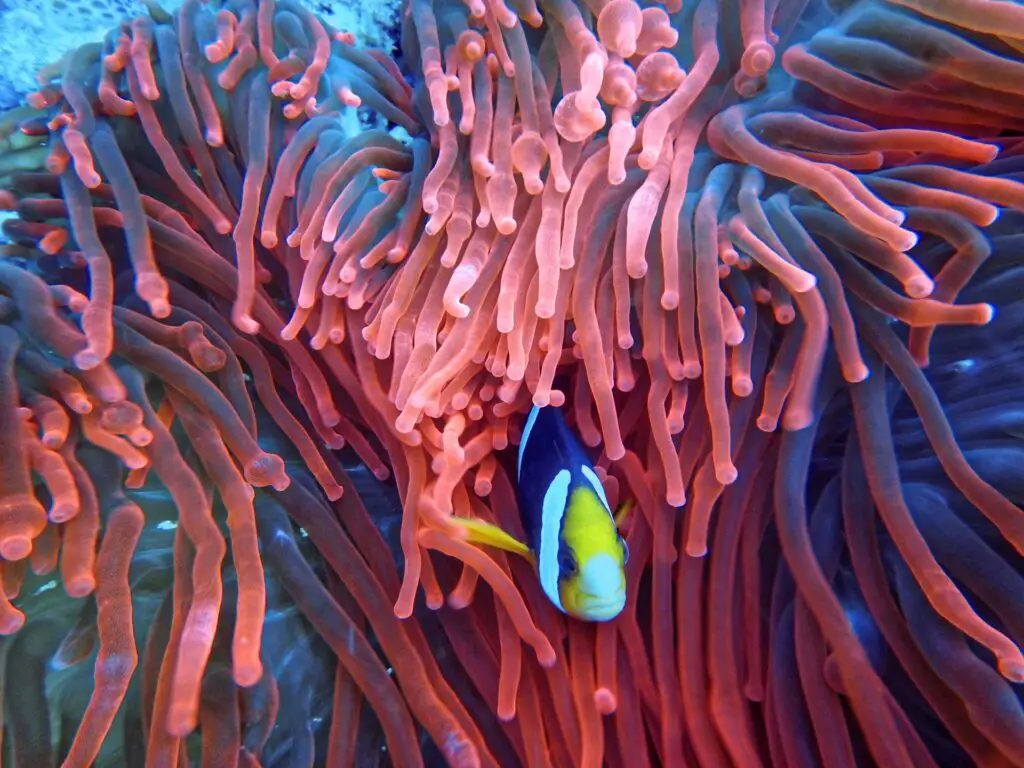
Sea Anemones require great care. Even the ones that are easiest to handle have light and water condition requirements. Besides, not all types of Anemones are friendly towards Clownfish. Adhesive, Bubble Tip, Delicate, Magnificent, and Beaded – these are among the types of Sea Anemones that get along with Clownfish.
2. Peppermint Shrimp
Peppermint Shrimp gets along with Clownfish well enough. But if your community tank has bright lighting, the shrimp won’t like it much. To keep it alive and kicking, put it in a place that remains dark almost all the time.
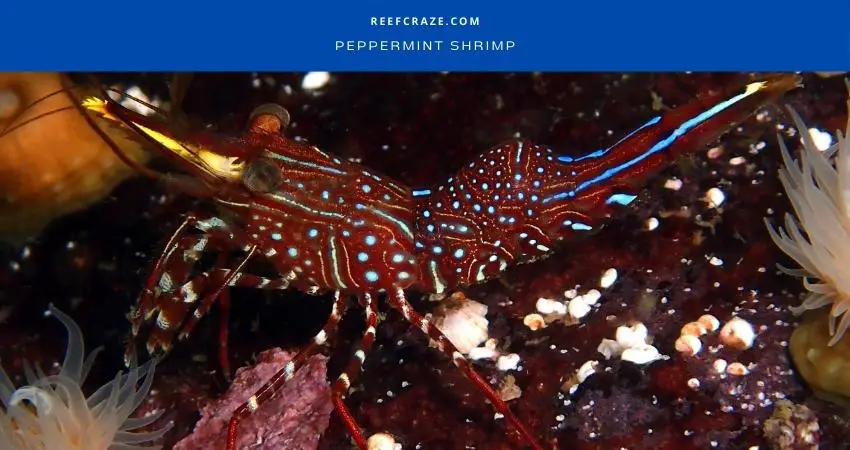
Detritus is the main food of this shrimp.
3. Blood Red Fire Shrimp
This tiny 2-inch shrimp is very peaceful in nature and makes a great tank mate for Pink Skunk Clownfish and Common Clownfish, which are also small in size.

It will eat any prepared or fresh food. It usually remains hidden if the tank has heavy lighting. It becomes active during dusk and night when it comes out of its hiding place and looks for missed pellets and flakes.
4. Crabs
Crabs can add a unique element of interest to a marine aquarium, often serving dual purposes as both intriguing spectacle and practical housekeepers. From a compatibility perspective, most crabs will coexist peacefully with clownfish. They typically occupy different parts of the tank, with crabs being bottom dwellers and scavengers, while clownfish prefer the middle to top levels. However, as with any species, individual behaviors can vary, and careful observation is necessary to ensure harmony in the tank.
Marine hermit crabs, such as the Blue Leg Hermit and the Red Leg Hermit, are beneficial algae and detritus eaters, effectively contributing to tank cleanliness. They are non-aggressive and tend to keep to themselves, which makes them good tank mates for clownfish. They require empty shells to inhabit as they grow, so providing a variety of shell sizes is necessary for their wellbeing. Aquarists often favor these species for their low maintenance and their efficiency in algae control.
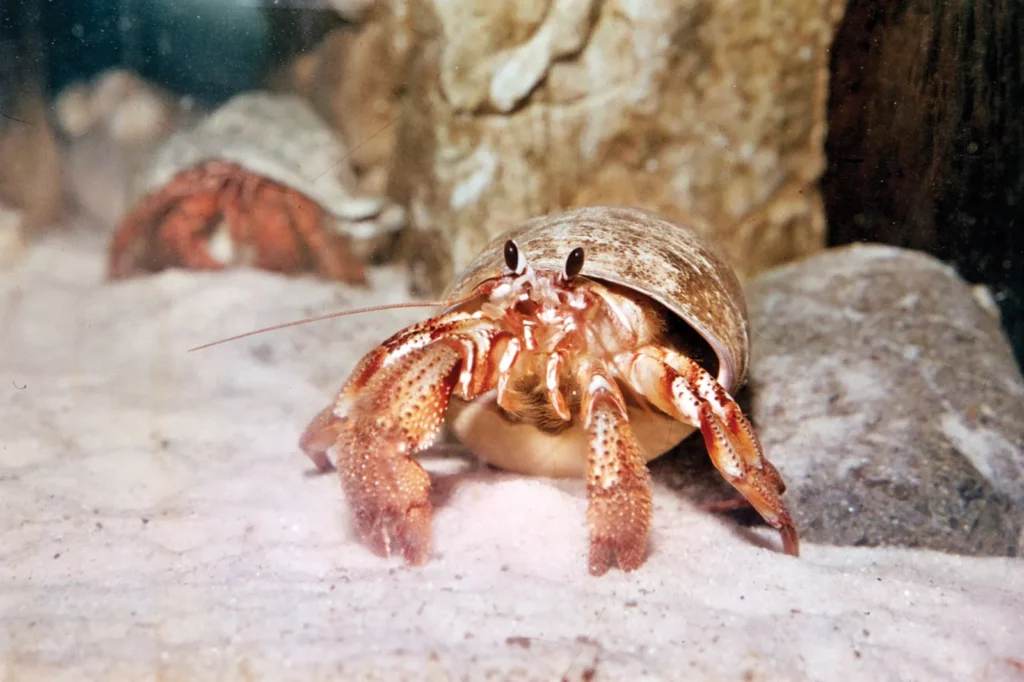
Emerald Crabs are another excellent option, especially valued for their ability to handle bubble algae, a challenging problem in many marine tanks. They are generally peaceful, but, like hermit crabs, they may need additional food sources if the algae levels are insufficient.
Porcelain Crabs, including the Porcelain Anemone Crab, are peaceful and reef-safe, making them a suitable choice as well. They are filter feeders and generally don’t bother other tank inhabitants. However, they do require stable water conditions, making them a slightly more delicate choice.
5. Harlequin Shrimp
- Scientific Name: Hymenocera picta
- Adult Size: Up to 2 inches
- Compatible with: Clownfish and most reef-safe species
- Water Temperature: 72 to 78 degrees Fahrenheit
- Minimum Tank Size: 20 gallons
- Care Level: Intermediate
- Origin: Indo-Pacific
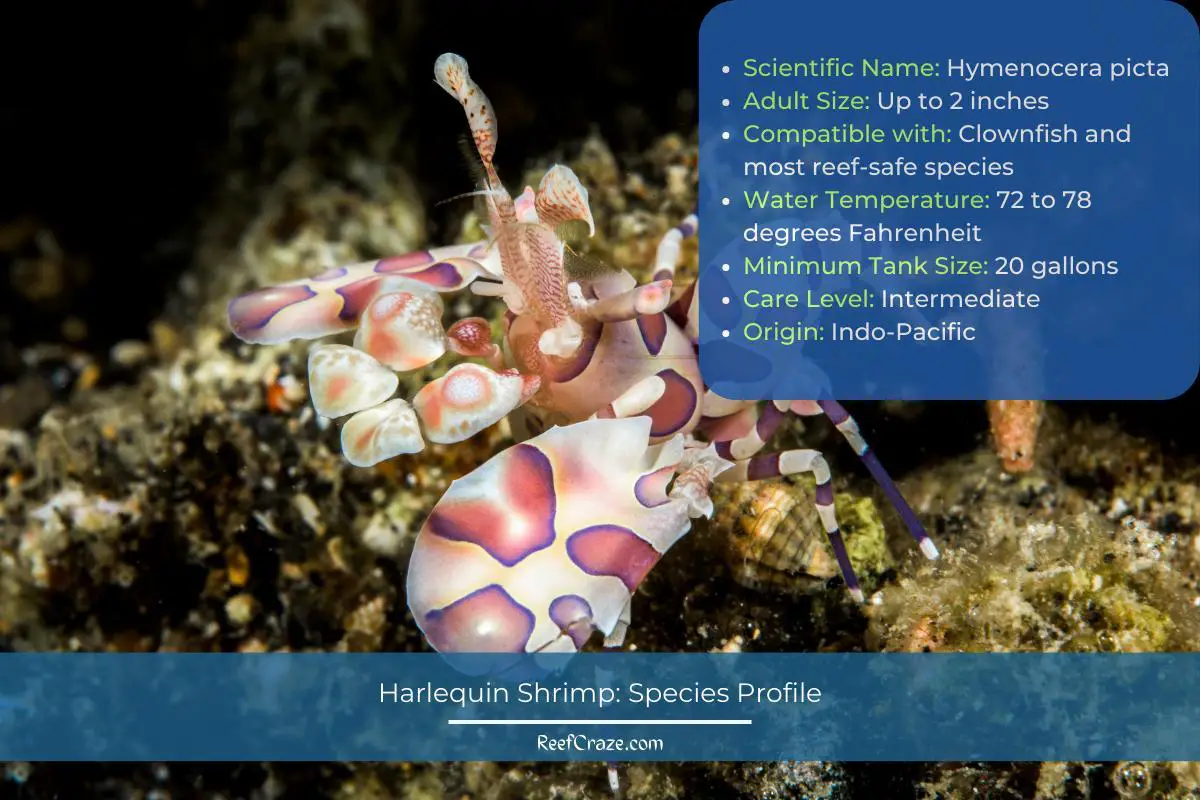
Harlequin Shrimp are fascinating and beautiful creatures. They’re not a threat to fish but have a specialized diet, feeding exclusively on starfish, including Asterina Starfish, which can sometimes become a pest in reef tanks.
However, this feeding habit can also make them challenging to care for, as providing a steady supply of starfish may be necessary. Compatibility with clownfish is typically excellent, as the shrimp pose no threat to the fish, but their dietary requirements must be taken into account when considering them as tank mates.
Potential Challenges in Introducing Tank Mates to Clownfish
Life isn’t all smooth sailing, and it’s the same in the world of fish tanks. There can be bumps, or in this case, bubbles along the way. Let’s discuss some potential challenges.
Issues with Aggressive Behavior
All it takes is one hot-headed resident to disrupt the peace in the tank. Aggressive behavior can be due to various reasons – hunger, lack of space, or a nasty temperament. The solution? Research well before you introduce a new fish to your clownfish tank.
Problems with Overcrowding
Think of your tank like a party. Too many guests, and things can get stuffy and uncomfortable. Overcrowding can lead to stress, disease, and even conflicts. Be mindful of the size and number of fish in the tank.
Risks of Disease Transmission
A sick fish in the tank can be like a sneezing passenger on a plane – not a pleasant situation. New tank mates should ideally be quarantined and observed for any signs of disease before introduction.
Food Competition
Imagine this – it’s feeding time, and the food disappears before you can say ‘bon appétit’. Food competition can lead to malnutrition and aggression. Make sure there’s enough food for everyone at the dinner table.
5 Tips: If You Want To Have A Clownfish Community Tank
Since you have got an idea about the perfect Clownfish tank mates by now, you can start planning for your Clownfish Community Tank. While you are at it, have a glance at the basics that you should keep in mind.
1. The Tank’s Minimum Capacity
Raising only one Clownfish will require you to have a 20-gallon tank at the very least. So, a community will have to be much larger. For a Clownfish community tank, the minimum capacity of the tank is 100 gallons of water.
The reason is quite simple. Clownfish itself needs enough space to swim. And its tank mates will need reefs, aquatic plants, wavers, etc.
2. No Female Clownfish
Here’s a fun fact about Clownfish – each of them is born male. Some of them change and become female fish later. So, if you have a community tank that is small in size, do not keep more than 2 of them there.
If you have a large community tank, try to keep the number of Clownfish even. Keeping 5, 7, 9 Clownfish wouldn’t be a good idea because it will leave one of them alone.
3. Put Small Sea Anemones
Just because your Clownfish bonds with Sea Anemones, it does not mean you have to keep large Anemones in the tank. Put the small ones. And choose those that do not sting much.
Also, wear gloves while handling Anemones. If you get stung by them, you may suffer from headaches and chest pain apart from blisters, rashes, and other discomforts.
4. Invest In Accessories
Clownfish and the tank mates of Clownfish need very stable water conditions in order to survive and grow. They can become sick and even die due to one small change in the water parameters.
Therefore, if you have a community tank, consider investing in some essential accessories that will help you to maintain the water condition. The accessories are a protein skimmer, pH meter, aquarium wave maker, aquarium filter, etc.
5. Maintaining Saltwater
Making a community tank with different types of fishes is relatively easy and exciting. The hard part is all the maintenance work – that’s what requires you to spend your time and effort.
The work is all manual. There is no equipment that will do the job for you. There are accessories that I already mentioned, and they will make it easier for you. Again, you have to learn it and do it all by yourself.
Everything needs to be kept up to the standard, from changing the salinity level to changing the temperature. So, you must know all about the maintenance requirements.
Frequently Asked Questions About Clownfish Tank Mates
Even with all this information, you may have some questions buzzing like busy bees in your mind. Let’s answer a few common ones.
Can Clownfish Live With Other Species Of Clownfish?
What Fish Should Not Be Kept With Clownfish?
How Many Fish Can Live In A Tank With Clownfish?
What To Do If Clownfish Become Aggressive Towards Tank Mates?
Final Words
Clownfish are not hard to raise. But remember to put Sea Anemones because Clownfish cannot survive without them. Small Anemones will be enough for 4 Clownfish. Please put them in a place where the other fishes cannot get to them.
A Clownfish community tank requires you to be skilled enough. This means that you will need to learn all the fundamentals of maintaining the tank to avoid mistakes. You will have to monitor the tank water and change it on a regular basis.
Besides, you will keep other types of fishes, and each of them will need different kinds of diets. Some of them will demand proper lighting, while others cannot tolerate it.
Again, the tank mates that you choose for your Clownfish may not get along with each other. For example, Basslets are not fond of Sea Anemones. Some of them cannot tolerate different species of their own.
Different species of fishes are prone to different diseases for which they will have to be treated differently.
The more variation you bring in your community tank, the more maintenance it will require. Apart from time and effort, it will also cause you to spend your money.
So, research as much as you can and be thorough about every single thing when you make a plan. A good plan will get you halfway through. Best wishes for your Clownfish community tank!
